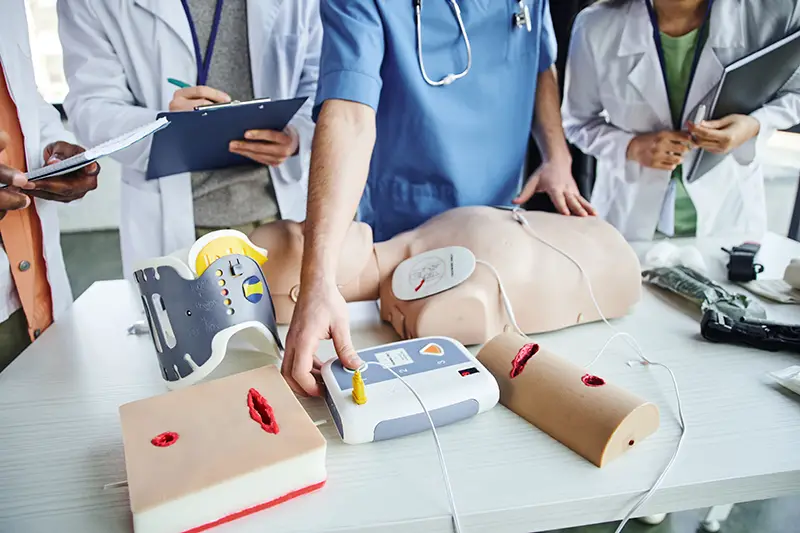Click here to get this post in PDF

When you run your own business, it’s up to you to ensure that you are creating a safe environment for your staff. There are health-and-safety regulations in place to make sure that you are protecting your workforce. Whether this is hard-hats and high-vis jackets or electronic device testing, your business will have to be assessed on its health-and-safety efforts.
These regulations are put in place to avoid injury in the workplace, but there are potentially fatal events that these rules don’t allow for. Sudden Cardiac Arrest (SCA) can happen to any person at any time, and without immediate treatment, the victim’s body will begin to shut down.
30,000 out-of-hospital cardiac arrests occur in the UK every year, and it’s estimated that 5% of these happen in the workplace, which amounts to 29 people each week. Although the ambulance service prioritises callouts for SCAs, the average response-time is 11 minutes in urban areas, by which point the victim’s chance of survival has reduced dramatically.
When a victim receives proper treatment within the first three-to-five minutes of suffering a cardiac arrest, their chance of survival increases from 6% to 74%, which means that bystander response offers the best possible chance of survival, particularly in the workplace. The only way to treat a sudden cardiac arrest is to deliver effective CPR and use a defibrillator early in the process.
What to Do if Your Employee Suffers a Sudden Cardiac Arrest
Work Out if It Is a Sudden Cardiac Arrest
Sudden cardiac arrest happens when there is a failure in the electrical signals that control the heart. This prevents blood from flowing around the body, causing it to shut down. It doesn’t take long for essential organs to die, meaning a fast reaction is essential to the victim’s survival.
If one of your employees collapses in the workplace, they might be suffering a sudden cardiac arrest. The first thing to do is establish whether they are breathing or not. If they aren’t breathing, they could be suffering a cardiac arrest, and you should then phone the emergency services. The operator will then proceed to give you instructions on how to perform CPR, and should be able to tell you where to find the nearest AED.
An AED is essential for contruction teams and contractors and having one on site can save lives. However, it is essential to choose the correct one – defibrillators at construction sites must be durable.
How to Perform CPR
Follow these instructions on how to perform CPR.
CPR works by compressing the chest and pushing blood around the body, thereby protecting the essential organs.
- First, you should put the heel of your hand on the person’s chest. You should then place your other hand on top, and lock your fingers together.
- Make sure that your shoulders are positioned directly above your hands, and press down six centimetres, ensuring that you use your full bodyweight.
- Keep your fingers interlocked, and allow the person’s chest to return to its original position after each compression.
- You should carry out 100-120 compressions per minute until you can access a defibrillator – or until the emergency services arrive.
Using an AED

An automatic external defibrillator (AED) is a machine that delivers a shock to the victim, in order to restore their heart back to a normal rhythm. The earlier a defibrillator is used on your employee, the more likely they are to survive.
Here are the steps:
- Turn the device on.
- Follow the visual or audio prompts on the machine.
- Deliver CPR until it tells you to stop, at which point it will then assess the victim’s heart rate.
- If a life-saving shock is needed, the machine will deliver one automatically or it will prompt the responder to press a button to do so. It will not deliver a shock to a person who isn’t suffering an SCA, so do not worry about the defibrillator causing more harm than good.
- Continue to perform CPR in between shocks.
Health-and-Safety Training in the Workplace
Out-of-hospital cardiac arrest is a prominent cause of death all over the world, and it can happen to anyone at any time – from sedentary office workers to super-fit athletes – meaning properly trained staff could be the difference between life and death. For each minute that passes following an SCA, the victim’s survival chances are reduced by a further 10%.
If an AED is used within the first minute of a sudden cardiac arrest, the victim’s chance of survival will remain at 90%. Emergency services can’t always reach a victim in time – particularly in urban areas where the average response-time is 11 minutes.
Equipping your business for a quick response to SCA could save a life.
You may also like: Heart Health in the Workplace
About the Author
This article is written by defibshop: the UK’s only independent defibrillator retailer. defibshop is working hard to ensure that businesses across the country are investing in their staff by purchasing defibrillators for their premises.
We earn a small commission if you shop through the link below
Image source: elements.envato.com
